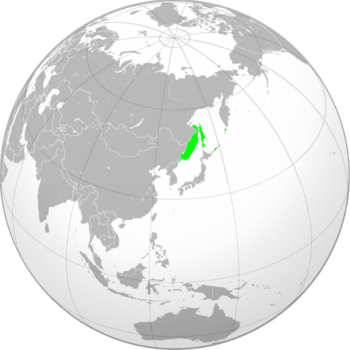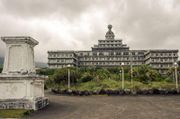Republic of East Asia
| Anthem: National Anthem of East Asia | |
 Area controlled by the Republic of East Asia shown in dark green; claimed but uncontrolled regions shown in light green. | |
| Status | Limited recognition |
| Capital | Haishenwai (de jure) Hachijo (de facto) |
| Official languages | 4 languages |
| Official scripts | 4 scripts |
| Ethnic groups | 64.1% Chinese 19.2% Korean 13.4% Japanese 3.3% others |
| Demonym(s) | East Asian |
| Government | Unitary parliamentary constitutional republic |
| Nelson Li | |
| Yoriko Ōishi | |
| Legislature | Parliament |
| House of Councillors | |
| House of Representatives | |
| Formation | |
| 11 February 2017 | |
| Area | |
• Total | [convert: invalid number] |
| Population | |
• 2017 estimate | 524 |
| Currency | East Asian dollar ($) (EAD) |
| Time zone | UTC+9 to +8 |
| Date format | dd-mm-yyyy yyyy年mm月dd日 |
| Driving side | right |
| Calling code | +81 |
| Internet TLD | .ea .东亚 .東アジア .동아시아 |
The Republic of East Asia, commonly known by its initials as REA, is a self-proclaimed sovereign country in East Asia subregion. Its neighbours include China to the southwest, North Korea to the south, Japan to the southeast, and Russia to the northwest.
The country is a multiethnic society encompassing a wide variety of cultures, languages, and religions. Its pluralistic makeup is reflected in the constitution's recognition of four official languages. One of these languages are of European origin: English is commonly used in public and commercial life, although Mandarin Chinese is spoken as the native tongue by the greatest number of East Asians, with 64.1% of the population using it as their home language. The Republic of East Asia is one of the few in Asia never to have had a coup d'état, and regular elections have been held since the establishment of the country.
Since the establishment of the Republic of East Asia, all ethnic and linguistic groups have held political representation in the country's democracy, which comprises a parliamentary republic and eight mainland provinces along with two overseas provinces, despite that most of the country's claimed territory is de jure controlled by the Republic of East Asia. The country is often considered the "Asian Rainbow" to describe REA's multicultural diversity. The government system is similarly modelled on the Westminster parliamentary system and the legal system is based on common law. The head of state is the President, although unlike most such republics the President is also head of government, and depends for his tenure on the confidence of Parliament. One of the members of the Asia-Pacific Micronational Economic Cooperation (APMEC), the Republic of East Asia is also part of the East Asia Summit of Micronations and a member of the British Commonwealth of Micronations.
Etymology
The name "East Asia" is derived from the country's geographic location at the far eastern tip of Asia. However, the country's name was confused with the region of East Asia, therefore the official name "Republic of East Asia" is often used to refer the country.
Politics and government

The Republic of East Asia is a parliamentary republic, although unlike most such republics the President is both head of state and head of government, and depends for his tenure on the confidence of Parliament. The executive, legislature and judiciary are all subject to the supremacy of the Constitution, and the superior courts have the power to strike down executive actions and acts of Parliament if they are unconstitutional.
The House of Representatives, the lower house of Parliament, consists of seventy members and is elected every five years by a system of party-list proportional representation. The House of Councillors, the upper house, consists of twenty members, with each of the ten provincial legislatures electing ten members.
After each parliamentary election, the House of Representatives elects one of its members as President; hence the President serves a term of office the same as that of the Assembly, normally five years. No President may serve more than two terms in office. The President appoints a Deputy President and Ministers, who form the Cabinet which consists of Departments and Ministries. The President and the Cabinet may be removed by the House of Representatives by a motion of no confidence.

